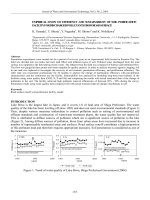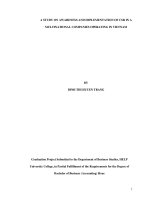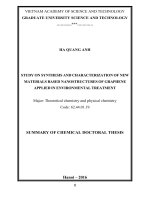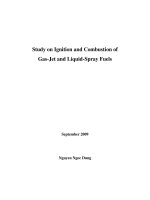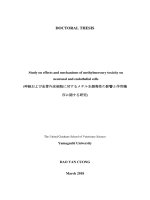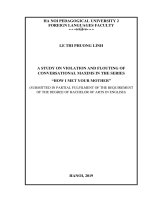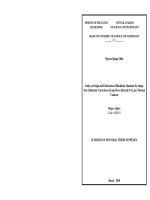Study on control and silulation of hv shield behavior
Bạn đang xem bản rút gọn của tài liệu. Xem và tải ngay bản đầy đủ của tài liệu tại đây (11.12 MB, 233 trang )
Nagaoka University of Technology
Niigata
Japan
Study on control and simulation of H&V
shield behavior
H&Vシールド機挙動の制御とシミュレーションに関する研究
Huynh Ngoc Thi
Study on control and simulation of H&V shield behavior
H&Vシールド機挙動の制御とシミュレーションに関する研究
A dissertation submitted in partial fulfillment of the requirements for the Degree
of Doctor of Engineering
by
HUYNH NGOC THI
Academic advisor: Prof. Mitsutaka Sugimoto
Department of Civil Engineering
Nagaoka University of Technology
Niigata, JAPAN
March, 2017
Acknowledgements
ACKNOWLEDGEMENTS
The author would like to express gratitude, great appreciation and indebtedness to his advisor
Professor Mitsutaka Sugimoto, who introduced him to shield tunneling field, for his
encouragement, invaluable guidance, support and apportion the knowledge throughout the
research. Without his guidance, providing a spur to the author confidence, the final works would
have never been reached.
A special gratitude is offered to his beloved wife Phan Thi Anh Thu for her emotional
support, patience and many sacrifices throughout the study period. She is always behind me and
encourages me. Her constant affection and forbearance have been a source of strength.
Acknowledgements are also extended to Professor Satoru Ohtsuka, Associate Professor
Hirofumi Toyota and Professor Osamu Takahashi for their insight, helpful discussions and
reviewing thesis manuscripts.
The author thanks to Dr. Chen Jian for invaluable help in various ways for academic, and
private matters throughout the research. Additionally, the author appreciates to the students of
Geotechnical laboratory, who contributed to the work of the research project, and provide an
enjoyable atmosphere.
The author deeply thanks to the faculties and other staff of Civil Engineering Department.
He will remain grateful to them for their cooperation during the study. He would also like to
thanks the members of Vietnamese Student Association for making his stay in Japan more
enjoyable.
i
Acknowledgements
Author wishes to thankful for financial supported by Monbusho Scholarship Program,
provided by the Ministry of Education, Culture, Sports, Science and Technology of Japan.
A special sincere appreciation extends to Associate Professor Le Van Nam and Dr. Dang
Dang Tung for their continuing supports and good wishes. Sincere appreciation goes to all those
who help in numerous ways in successfully completing this piece of research work.
Finally, the author dedicates this little piece of work to his father and mother for their strong
encouragement, tremendous sacrifices given to him.
Huynh Ngoc Thi
Nagaoka University of Technology, Japan
ii
Abstract
ABSTRACT
Due to limited underground space in the urban area and for saving construction cost, multicircular face shield (MF shield) had been innovated to construct a twin tunnel at once.
Furthermore, according to the more severe restriction of underground space use, horizontal and
vertical variation shield method (H&V shield) was innovated, so that the cross section of an MF
shield tunnel is changed from horizontal multi-circular shape to vertical one or vice versa. The
H&V shield is manufactured by connecting two articulated shields at their rear bodies and is
steered by articulation mechanism and copy cutter, which can be operated individually at each
body. These steering options can generate rotating force around the shield axis, which can realize
the construction of a spiral tunnel.
The characteristics of H&V shield method, compared with other type shields, are as follows:
1) Tunnel shape and alignment: H&V shield can construct a separate tunnel and a spiral tunnel.
In the case of a separate tunnel, H&V shield forms a tunnel with a multi-circular cross section at
first, and two ordinary tunnels with a circular cross section after a specified point along the tunnel
alignment by separating the H&V shield to two ordinary shields. On the other hand, in the case
of a spiral tunnel, H&V shield constructs a tunnel with a multi-circular cross section, which is
changed continuously from horizontal multi-circular shape to vertical one, or vice versa; 2)
Construction period: H&V shield can shorten a construction period because H&V shield can
omit an intermediate vertical shaft to separate the body in the case of a separate tunnel, and can
construct multiple tunnels at once in the case of a spiral tunnel; and 3) Construction cost: H&V
iii
Abstract
shield can save a construction cost because H&V shield body can separate without an
intermediate vertical shaft and a ground improvment in the case of a separate tunnel, and can
reduce the adjacent distance between two circular tunnels in the case of a spiral tunnel.
Shield is operated for excavation, steering shield, filling up in the tail void, and segment
installation mainly. As for steering shield, the shield is controlled by jack, copy cutter and
articulation mechanism in practice. The jack generates thrust and horizontal and vertical moment,
which can be determined by jack pattern and shield jack pressure. The copy cutter can carry out
overcutting with a specified depth and a specified range along the circumference of cutter face.
The overcutting by copy cutter defines excavation area and reduces ground reaction force at the
overcutting range, which makes the shield rotate toward the overcutting range easier. The
articulation mechanism for articulated shield can crease shield with a specified direction and a
specified angle. The crease of the shield can reduce ground reaction force at curves by fitting the
shield for its excavation area, which makes the shield rotate easily.
H&V shield for a spiral tunnel can be controlled by spiral jacks, copy cutter and articulation
system. The shield jack system including spiral jacks, causes the eccentric forces to generate
torque to twist an H&V shield around its axis. The copy cutter can reduce the ground reaction
force at a specified area by overcutting the ground, and the articulation system also can reduce
the ground reaction force by articulating the front body from the rear body of each shield. Using
these functions, H&V shield can rotate around its axis and can advance, thus, H&V shield can
construct a spiral tunnel.
Recently, a construction project has been planned using H&V shield method. Because of the
limitation of land use, such as, narrow river and existing structures over the planned route of the
tunnel, only the spiral excavation mode of this method can construct the tunnel, of which the
cross section enables the required amount to be discharged. However, this is the first application
iv
Abstract
in practice except for the test execution. Therefore, this study aims to examine the H&V shield
control method before the construction.
At first, the shield steering parameters, such as, copy cutter operation (length and range) and
articulation operation (direction and angle), were determined, based on the geometric conditions
for both bodies of H&V shield independently. After that the jack operation (jack thrust force,
horizontal moment and vertical moment) were determined, using the kinematic shield model for
H&V shield. Next, the H&V shield behavior was simulated using the kinematic shield model for
H&V shield, which has been developed from the one for the single circular shield to simulate
H&V shield behavior during excavation theoretically based on equilibrium conditions. In the
simulation process, the ground displacement around the shield was taken into account, and the
shield operational parameters obtained from the above were also used. In this process in order to
validate the model performance, the calculated shield behavior was examined from the viewpoint
of theory, and the H&V shield control method was confirmed by comparing the calculated shield
behavior with the plan data. Besides, the force acting at the connection point between the left
body and the right body was calculated for shield design. This paper describes the H&V shield
behavior at the a curve.
As a result, the followings were found: 1) The calculated H&V shield behavior is reasonable
from the viewpoint of the theory and site experience. 2) The calculated shield behavior has an
overall good agreement with the planned one; 3) The ground displacement is a predominant
factor affecting shield behavior; and 4) The proposed model can simulate the H&V shield
behavior reasonably.
v
Table of contents
TABLE OF CONTENTS
ACKNOWLEDGEMENTS ........................................................................................................ i
ABSTRACT .............................................................................................................................. iii
TABLE OF CONTENTS........................................................................................................... vi
LIST OF TABLES ..................................................................................................................... xi
LIST OF FIGURES .................................................................................................................. xii
CHAPTER 1: INTRODUCTION............................................................................................... 1
1.1 Background .................................................................................................................... 1
1.2 Mechanized Shield Tunneling Work ............................................................................ 3
1.2.1 Shield Tunneling Works ........................................................................................... 3
1.2.1.1 General Aspect of Shield Tunneling Method ................................................... 3
1.2.1.2 Shield Tunneling Machine Types ..................................................................... 3
1.2.1.3 Ground Responses Caused by Shield Tunneling.............................................. 5
1.2.2 Shield Tunneling Control ......................................................................................... 7
1.2.2.1 Face Stabilization ............................................................................................. 8
1.2.2.2 Muck Volume ................................................................................................. 12
1.2.2.3 Back filling ..................................................................................................... 12
1.2.2.4 Tail Seal .......................................................................................................... 13
1.2.2.5 Shield Direction .............................................................................................. 14
1.2.3 Horizontal and Vertical Variation Shield Method .................................................. 14
1.2.3.1 Concept ........................................................................................................... 14
1.2.3.2 Characteristics ................................................................................................ 14
1.2.3.3 Mechanism of Tunnel Driving ....................................................................... 15
vi
Table of contents
1.3 Literature Review ........................................................................................................ 16
1.3.1 Shield behavior ...................................................................................................... 16
1.3.2 Ground movement.................................................................................................. 18
1.4 Simulation Method of Shield Behavior ...................................................................... 20
1.4.1 Kinematic shield model ......................................................................................... 20
1.4.2 Simulation method of single circular shield .......................................................... 21
1.4.3 Simulation Method of Articulated Shield .............................................................. 23
1.5 Objective of This Study ............................................................................................... 24
CHAPTER 2: METHODOLOGY ............................................................................................ 25
2.1 Calculation Method Of Steering Parameters ............................................................ 25
2.1.1 Calculation conditions............................................................................................ 25
2.1.2 Coordinate System ................................................................................................. 26
2.1.2.1 Definition........................................................................................................ 26
2.1.2.2 Coordinate Transformation............................................................................. 26
2.1.3 Tunnel Alignment Description ............................................................................... 27
2.1.3.1 Spatial Curve .................................................................................................. 27
2.1.3.2 Discretization and Interpolation ..................................................................... 29
2.1.4 Articulation Angle .................................................................................................. 31
2.1.5 Machine Type ......................................................................................................... 34
2.1.6 Excavation Stage .................................................................................................... 34
2.1.6.1 Operation Rules at Curve ............................................................................... 35
2.1.6.2 Operation Rules around BC ........................................................................... 35
2.1.6.3 Operation Rules around EC ............................................................................ 35
2.1.7 Calculation Method for Articulation Angle ........................................................... 36
2.1.7.1 Type 1 ............................................................................................................. 36
vii
Table of contents
2.1.7.2 Type 2 ............................................................................................................. 38
2.1.7.3 Type 3 ............................................................................................................. 40
2.1.8 Calculation Method for Copy Cutter Length ......................................................... 40
2.2 Simulation Method of H&V Shield Behavior............................................................ 45
2.2.1 Types of Forces ...................................................................................................... 45
2.2.1.1 Self-weight of the Shield f1 ............................................................................ 47
2.2.1.2 Forces on the Shield Tail f2 ............................................................................. 47
2.2.1.3 Jack Force f3 ................................................................................................... 52
2.2.1.4 Force at the Face f4 ......................................................................................... 53
2.2.1.5 Earth Pressure Acting on the Shield Periphery f5 ........................................... 59
2.2.2. Summations of Forces, Moments, and Cutter Torque........................................... 61
2.3 Simulation Algorithms ................................................................................................. 62
2.3.1 General ................................................................................................................... 62
2.3.2 Simulation Techniques ........................................................................................... 63
2.3.3 Indexes of Shield Tunneling Behavior ................................................................... 65
2.3.3.1 Curvature on the Vertical Plane ...................................................................... 66
2.3.3.2 Tilt Angle on the Vertical Plane ...................................................................... 66
2.3.3.3 Curvature on the Horizontal Plane ................................................................. 67
2.3.3.4 Tilt Angle on the Horizontal Plane ................................................................. 68
CHAPTER 3: SENSITIVITY ANALYSES ............................................................................. 69
3.1 Introduction ............................................................................................................. 69
3.1.1 Analysis Data ......................................................................................................... 69
3.1.2 Analysis Parameters ............................................................................................... 69
3.2 Parameter 1: Copy Cutter Length......................................................................... 70
3.2.1 Shield Behavior ................................................................................................. 70
viii
Table of contents
3.2.2 Trace .................................................................................................................. 71
3.2.3 Force .................................................................................................................. 71
3.2.4 Gap Around Shield Periphery............................................................................ 72
3.2.5 Effective Normal Earth Pressure ....................................................................... 73
3.2.6 Summary ........................................................................................................... 73
3.3 Parameter 2: Crease Angle θCV and Pitching Angle
fpRR ................................. 74
3.3.1 Shield Behavior ................................................................................................. 74
3.3.2 Trace .................................................................................................................. 76
3.3.3 Force .................................................................................................................. 76
3.3.4 Gap Around Shield Periphery............................................................................ 76
3.3.5 Effective Normal Earth Pressure ....................................................................... 77
3.5.6 Summary ........................................................................................................... 77
3.4 Parameter 3: Share of Jack Force For Both Bodies............................................. 78
3.4.1 Shield Behavior ................................................................................................. 79
3.4.2 Trace .................................................................................................................. 79
3.4.3 Force .................................................................................................................. 80
3.4.4 Gap Around Shield Periphery............................................................................ 80
3.4.5 Effective Normal Earth Pressure ....................................................................... 81
3.4.6 Summary ........................................................................................................... 81
3.5 Parameter 4: Ground Stiffness .............................................................................. 82
3.5.1 Shield Behavior ................................................................................................. 82
3.5.2 Trace .................................................................................................................. 82
3.5.3 Force .................................................................................................................. 82
3.5.4 Gap Around Shield Periphery............................................................................ 82
3.5.5 Effective Normal Earth Pressure ....................................................................... 83
ix
Table of contents
3.5.6 Summary ........................................................................................................... 83
CHAPTER 4: APPLICATION ................................................................................................. 84
4.1 Site Description ............................................................................................................ 84
4.2 Simulation of H&V Shield at a Sharp Curve ............................................................ 84
4.2.1 Operation Data ....................................................................................................... 85
4.2.2 Simulation Results ................................................................................................. 86
4.2.2.1 H&V Shield Behavior .................................................................................... 86
4.2.2.2 Ground-shield Interaction............................................................................... 87
4.2.2.3 Forces and Moments Acting on the Shield ..................................................... 89
4.3 Simulation of H&V Shield at the Spiral Section ....................................................... 90
4.3.1 Operation data ........................................................................................................ 90
4.3.2 Simulation Results ................................................................................................. 91
4.3.2.1 H&V Shield Behavior .................................................................................... 91
4.3.2.2 Ground-shield Interaction............................................................................... 92
3.3.2.3 Forces and Moments Acting on the Shield ..................................................... 94
CHAPTER 5: CONCLUSIONS ............................................................................................... 95
REFERENCES ......................................................................................................................... 98
APPENDIX
TABLES
FIGURES
x
List of tables
LIST OF TABLES
Table 1.1 Selection of shield (JSCE, 1986).
Table 1.2 Summary of changes of earth pressure during shield tunneling operation with passing
of time (Revised from JSSMFE, 1993).
Table 1.3 Proportion of settlement by settlement type (Makata, 1981 and Yamada et al., 1988).
Table 2.1 Parameters at =0, 1/2, 1.
Table 2.2 Operational sign.
Table 2.3 Machine types
Table 2.4 Operation rule at curve.
Table 2.5 Judging conditions of Type 1 for shield position.
Table 2.6 Judging conditions of Type 2 for shield position
Table 2.7 Judging conditions of Type 3 for shield position.
Table 2.8 Position vector r* and unit normal direction vector k * in analysis
Table 2. 9 Relationship between applications of shield model and affecting factors.
Table 3.1 Shield data used in the analysis
Table 3.2 Ground parameters
Table 3.3 Analysis case
Table 4.1 Ground properties
Table 4.2 Dimensions of tunnel and shield
Table 4.3 Force and moment acting on shield (at distance 4.345m)
Table 4.4 Force and moment acting on shield (at distance 22.574m)
Table 4.5 Force and moment acting on shield (at distance 125.5m)
xi
List of figures
LIST OF FIGURES
Figure 1.1 Mechanism of shield movement (Shimizu and Suzuki, 1992).
Figure 1.2 Construction sequences of shield tunneling works (Fujita, 1989).
Figure 1.3 Illustration of ground movement caused by shield tunneling work (JSSMFE, 1993).
Figure 1.4 Relationships between ground displacement and affecting factors (Makata, 1980).
Figure 1.5 Ground surface settlement in longitudinal direction (JGS, 1996).
Figure 1.6 Ground surface settlement in transverse direction (JGS, 1996).
Figure 1.7 Three dimensional displacement of ground around the cutter face for clayey soil
(JGS, 1996).
Figure 1.8 Three dimensional displacement of ground around the cutter face for sandy soil
(JGS, 1996).
Figure 1.9 Illustration of pressure acting on cutter face (Kanayasu et al., 1995).
Figure 1.10 Relationship between earth pressure and deformation (Sugimoto et al., 1992).
Figure 1.11 An example of control system for face stabilization and excavated soil volume of
slurry shield.
Figure 1.12 An example of automatic back filling control system.
Figure 1.13 Installation of wire brush seal on the inside shield tail.
Figure 1.14 An example of automatic shield direction control system.
Figure 1.15 H&V shield. (STA 2011b)
Figure 1.16 Utilization of H&V shield. (STA 2011b)
Figure 1.17 Spiral jack. (STA 2011b)
Figure 1.18 Copy cutter and articulated mechanism in excavation. (STA 2011b)
Figure 1.19 Model to analyze taking tail void and segment rigidity into consideration
xii
List of figures
(Yamada et al., 1979).
Figure 1.20 Model of loads acting on shield (Sugimoto and Sramoon 2002).
Figure 1.21 Ground reaction curve.
Figure 1.22 Definition of displacement of excavated surface for stiff ground
Figure 1.23 Model of load acting on both of right and left body of H&V shield.
Figure 2.1 Flowchart of numerical procedure for articulation angle and copy cutter length.
Figure 2.2 Coordinate systems.
Figure 2.3 Fundamental unit vectors of a spatial curve.
Figure 2.4 Relation between articulation angle and direction vectors.
Figure 2.5 Dimension of articulated shield.
Figure 2.6 Crease Type 1.
Figure 2.7 Crease Type 2 and Type 3.
Figure 2.8 Operation rules at BC section for all types.
Figure 2.9 (a) Operation rules at EC section for Type1.
Figure 2.9 (b) Operation rules at EC section for Type2.
Figure 2.9 (c) Operation rules at EC section for Type3.
Figure 2.10 Contact condition of Type 1 at curve section.
Figure 2.11 Contact condition of Type 2 at curve section.
Figure 2.12 Contact condition of Type 3 at curve section.
Figure 2.13 Concept to calculate copy cutter length.
Figure 2.14 Calculation points for Procedure A.
Figure 2.15 Calculation points for Procedure B.
Figure 2.16: Model of load acting on both front body and rear body of H&V shield
Figure 2.17 Coordinate systems.
Figure 2.18 Definition of jack position measurement.
xiii
List of figures
Figure 2.19 Definition of division on front face.
Figure 2.20 Pressure on cutter face.
Figure 2.21 Definition of length measured on shield.
Figure 2.22 Definition of calculation point on cutter face periphery.
Figure 2. 23 Factors affecting shield model.
Figure 2.24 Description of Rv and q vT
Figure 2.25 Description of Rh and q xT
Figure 3.1 Shield behavior (Parameter 1: CCL)
Figure 3.2 Shield behavior (curvatures and tilt angles on the horizontal and vertical planes)
(Parameter 1: CCL)
Figure 3.3 Trace of shield on the vertical and horizontal plan (Parameter 1: CCL)
Figure 3.4 Forces and Moments against distance (Parameter 1: CCL)
Figure 3.5 Gap around the shield periphery (Parameter 1: CCL)
Figure 3.6 Effective normal earth pressure on the shield periphery (Parameter 1: CCL)
Figure 3.7 Shield Behavior (Parameter 2: Crease Angle and Pitching Angle, fpRR 0.5q CV )
Condition 1)
Figure 3.8 Shield Behavior (Parameter 2: Crease Angle and Pitching Angle, fpRR q CV )
Figure 3.9 Trace of shield on the vertical and horizontal plane (Parameter 2: Crease Angle and
Pitching Angle, fpRR 0.5q CV )
Figure 3.10 Trace of shield on the vertical and horizontal plane (Parameter 2: Crease Angle and
Pitching Angle, fpRR q CV )
Figure 3.11 Forces and Moments against distance (Parameter 2: Crease Angle and Pitching
Angle, fpRR 0.5q CV )
Figure 3.12 Forces and Moments against distance (Parameter 2: Crease Angle and Pitching
xiv
List of figures
Angle, fpRR q CV )
Figure 3.13 Gap around the shield periphery (Parameter 2: Crease Angle and Pitching Angle,
fpRR 0.5q CV )
Figure 3.14 Gap around the shield periphery (Parameter 2: Crease Angle and Pitching Angle,
fpRR q CV )
Figure 3.15 Normal effective earth pressure on the shield periphery (Parameter 2: Crease Angle
and Pitching Angle, fpRR 0.5q CV )
Figure 3.16 Normal effective earth pressure on the shield periphery (Parameter 2: Crease Angle
and Pitching Angle, fpRR q CV )
Figure 3.17 Shield Behavior (Parameter 3: Share of jack force for both bodies)
Figure 3.18 Trace of shield on the vertical and horizontal plane (Parameter 3: Share of jack
force for both bodies)
Figure 3.19 Forces and moments against distance (Parameter 3: Share of jack force for both
bodies)
Figure 3.20 Gap around the shield periphery (Parameter 3: Share of jack force for both bodies)
Figure 3.21 Normal effective earth pressure on the shield periphery (Parameter 3: Share of jack
force for both bodies)
Figure 3.22 Shield behavior (Parameter 4: Ground stiffness)
Figure 3.23 Trace of shield on the vertical and horizontal plane (Parameter 4: Ground stiffness)
Figure 3.24 Forces and moments against distance (Parameter 4: Ground stiffness)
Figure 3.25 Gap around shield periphery (Parameter 4: Ground stiffness)
Figure 3.26 Normal effective earth pressure on the shield periphery (Parameter 4: Ground
stiffness)
Figure 4.1 Site location and geological profile
xv
List of figures
Figure 4.2 Ground reaction curve of the soil layers at the construction.
Figure 4.3 Dimension of H&V shield machine.
Figure 4.4 Shield tunneling input data at sharp curve
Figure 4.5 Calculated and planned shield traces at sharp curve
Figure 4.6 Calculated and planned shield behavior.at sharp curve
Figure 4.7 Un around shield on the straight line at 4.345 m.
Figure 4.8 sn’ around shield on the straight line at 4.345m.
Figure 4.9 Un around shield on the sharp curve at 22.574m.
Figure 4.10 sn’ around shield on the sharp curve at 22.574m.
Figure 4.11 Shield tunnelling input data at spiral section
Figure 4.12 Calculated and planned shield traces at spiral section
Figure 4.13 Calculated and planned shield behavior at spiral section
Figure 4.14 Un around shield on the spiral section at 125.5m.
Figure 4.15 sn’ around shield on the spiral section at 125.5m.
xvi
Chapter 1: Introduction
CHAPTER 1: INTRODUCTION
1.1 Background
The main construction method of tunnels under groundwater level in soft ground of urban
areas is shield tunneling method. Shield tunneling method is developed to minimize the
disturbance of the surrounding ground and also to install the ground support under the protection
of the shield.
Shield tunneling method is defined as any method in which a solid cylinder, or shield, is
driven through the ground. The tunnel lining is constructed inside the shield to prevent the ground
from collapsing. At the beginning, the shield tunneling used a manual type with an open face.
The slurry shield and the earth pressure balanced (EPB) shield were developed around 1970. The
machines are classified based on the face support method and the cutting technique. The slurry
shield and the EPB shield are classified together as the closed-type shield, which were popular
tunneling methods in the soft ground tunneling during the past decade.
The planned alignment of shield tunneling method should be designed as simple as possible.
A straight line or a gradual curve with a large radius on 2-D horizontal plane is generally desired.
However, due to completeness of infrastructures in urban areas, underground space at shallow
depth is congested constantly. To construct new tunnel projects, deep-depth space starts to be
used, which increases the opportunities on the use of vertical alignments. This fact involves the
using of 3-D compound alignments. Furthermore, due to shield adjacent construction near
existing structures, the precise control of shield is being placed on the agenda. Taking a wide
view of present technologies on precise control of shield, they have not yet been developed well
under complex conditions.
1
Chapter 1: Introduction
As for shield control, too many control parameters reflect as the following aspects: (1)
Excavation area, which involves copy cutter range, length, and articulation angle; (2) Forces
(including thrust, horizontal, and vertical moments), which are determined by jack pattern and
shield jack pressure; and (3) Stability of excavation face, which involves face pressure, advancing
speed, and mucking rate.
Excavation area is the predominant factor to influence shield behavior, which can be
determined by geometrical relations under certain conditions. However, it is not enough to ensure
excavation area only. Conditions of force equilibrium should be considered at the same time.
Jack force and jack moment give small influences to shield behavior, compared with the
influences of excavation area. To consider the force equilibrium, it is necessary to ensure stability
of excavation face. Stability of excavation face is also an important factor to control the
settlement of ground surface. At present, technologies on stability control of excavation face have
been developed very well.
As for the first step to develop a precise control system of shield, the kinematic shield model
had been developed. Based on the operation data including copy cutter length, range, and
articulation angle, the kinematic shield model was verified by in-situ data. Secondly, a numerical
method to calculate copy cutter length and range and articulation angle on 3-D compound
alignments had been developed by considering discrete shield trace. At present, similar
calculation methods by shield manufacturers just can consider 2-D circular alignments. This
numerical method can consider straight, circular, and clothoid curves on the horizontal plane and
straight, circular, and parabolic curves on the vertical plane. But it is a problem that this method
cannot be applied to the special alignments which do not follow the above alignment.
The direction control systems of shield machine based on empirical relationships were
developed. These systems cannot take into account the excavation area around the shield, which
is considered to be the predominant factor affecting the shield behavior.
2
Chapter 1: Introduction
1.2 Mechanized Shield Tunneling Work
1.2.1 Shield Tunneling Works
1.2.1.1 General Aspect of Shield Tunneling Method
The shield tunneling method was invented by M.T. Brunel in the United Kingdom in 1818,
and it was used first in 1825 for constructing a tunnel under the Thames River. The shield is
usually a cylindrical steel shell to prevent the ground from collapsing and to provide the space
for the excavation and the lining as well. The shell is supported by ribs and ring girders and is
moved by built-in hydraulic jacks. Figure 1.2 shows the construction sequences of shield
tunneling with simplified longitudinal sections of a conventional type of shield (Fujita 1989).
Various pieces of equipment and other devices are installed in the shield to make the operation
easier. The shield is assembled in the launching shaft, and the construction sequences of the
shield tunneling can be described as follows:
(1) Excavate ahead for a distance equivalent to the length of one segmental lining. Support
the face if necessary by the jacks, the sheeting, and/or the face supporting pressure.
(2) Advance the shield one-ring length forward by applying the jack thrust against the
lining, which is already built.
(3) Install the segments of one-ring length in the shield tail after retracting the jacks.
(4) Fill the tail void, which is developed between the lining and the opening ground, by
grouting.
1.2.1.2 Shield Tunneling Machine Types
Various types of shields have been developed to increase the advanced rate of excavation to
save the construction costs and to maintain the face stability under various ground conditions.
The shields have been classified into three categories: the open face type, the partial open face
type, and the closed face type, according to the interaction at the tunnel face (JSCE 1986).
3
Chapter 1: Introduction
In the open-face-type shield or the open-type shield, either the full face or part of the face is
opened for excavation. It can be used for self-stabilized ground. This type includes the handmining shield, the excavator shield and the mechanical shield. The partial open face type shield
is the blind shield. The collapse of the face is prevented by a bulkhead for a blind shield. It is
meant that the muck through the slits on the rotary cutting head, is free from any pressure
immediately.
It is possible to classify the balanced face type shield or the closed type shield into the slurry
shield and the earth pressure balanced (EPB) shield. The EPB shield intends to secure the stability
of the face by applying a constant pressure to chamber. It is composed of an excavation
mechanism to excavate the ground, a mixing mechanism to agitate the excavated soil, a discharge
mechanism to discharge the excavated soil, and a control mechanism to give a certain degree of
binding strength to the excavated soil. In some cases, the EPB shield tunneling method uses soil
additives to lubricate the soil. In comparison, the slurry shield circulates the pressurized slurry to
stabilize the face while transporting the excavated soil in fluid form. The slurry shield is
composed of an excavation mechanism to excavate the ground, an agitated mechanism to mix
the excavated soil with slurry, a slurry feed mechanism to circulate the slurry, a slurry processing
mechanism to process the slurry transport after initial excavation, and a slurry adjustment
mechanism to feed the face with predetermined properties of slurry.
The difference between the EPB shield and the slurry shield is the face pressure, which is
given to the excavated soil in the chamber to balance or to cope with the overburden pressure
and the groundwater pressure acting on the face. Consequently, the use of the slurry shield or the
EPB shield produces a good result in minimizing the ground movement or settlement.
In selecting the shield type used for tunneling, it is important to maintain the ground surface
settlement or the ground movement to a minimum to achieve safety and economical operation.
The main factors in selecting the type of shield includes the construction period, the ground
4
Chapter 1: Introduction
conditions, the tunnel length, the tunnel depth, the cross-sectional area, the minimum radius of
the tunnel curvature, and the nature of the surrounding ground conditions. Fujita (1989) defined
the ground conditions affecting the selection of the shield type as follows:
(1) Ground-water level;
(2) Physical properties of soil;
(3) Composition of strata;
(4) Size and amount of gravel and boulders;
(5) Existence of obstacles;
(6) Existence of explosive gas or deoxidizing materials;
(7) Amount of inflow water.
JSCE (1986) proposed the applicable shield type for the various ground conditions as shown
in Table 1.1.
1.2.1.3 Ground Responses Caused by Shield Tunneling
The earth pressure acting on the shield or the lining changes in accordance with the ground
deformation around the tunnel during construction. When the ground deformation around the
tunnel occurs inward to the tunnel, the earth pressure decreases in proportion to the degree of
deformation, that is, active earth pressure. In contrast, when the ground deformation around the
tunnel appears outward from the tunnel, the earth pressure becomes passive. The earth pressure
acting on the tunnel is governed not only by the tunnel shape and the characteristics of the ground,
but also by many other factors, such as the excavation method, the control of shield, the stiffness
and the erection timing of the lining, the grouting method, and the groundwater conditions.
JSSMFE (1993) proposed the imaginative ground movement, where the tunnel is excavated
by a shield, as illustrated in Figure 1.3. The earth pressure acting on the shield or the lining, which
5
Chapter 1: Introduction
includes the subgrade reaction, changes in accordance with the difference stages of the ground
movements along the tunnel wall as defined in Table 1.2 and can be explained as follows.
The first step is where the shield face has not reached an observed point in the ground,
nevertheless, the ground movement appears even at this stage. In case of the open type shield
tunneling work, the ground at the face deforms toward inside of the tunnel. In contrast, with the
closed-type shield tunneling method, the ground would be deformed outward away from the
tunnel face, provided that the total face pressure, which is composed of slurry pressure or mud
pressure and support pressure by cutter face should be slightly greater than the earth pressure at
rest at the face.
The second step is located at the actual digging of the ground by the cutter bit of the shield
or by hand. If the fluid pressure can adequately support the face and the ground around the face,
there would be little ground movement. In case of the open-type shield tunneling, even the
compressed air is simultaneously applied, the ground movement would be deformed toward the
tunnel.
The third step is where the shield actually passes the ground at the consideration point. At
this step, the ground movement depends on deviation and rotation of the shield and local collapse
of the ground around the shield since the ground is supported by the shield periphery. It is
believed that it is impossible to create the fluid pressure strong enough to prevent the ground
movement, even in case of the closed-type shield tunneling work.
The fourth step is considered that the shield has completely passed an observed point in the
ground, and the segment lining assembled inside the shield tail is detached from the shield tail.
At this moment, the tail void is created between the lining and the excavation surface. Any delay
in backfilling or delay in hardening of the back-filling materials leads to the ground deformation
toward to this tail void.
6
Chapter 1: Introduction
The fifth step is considered when consolidation settlement or creep deformation of the
ground and back-filling materials gradually appear with diminishment of the three dimensional
supporting effect by further advancement of the shield upon completion of the backfilling. At
this stage, the soft cohesive soil begins to consolidate as its soil structure collapses, whereas the
creep deformation is appeared in cohesionless soil.
While the ground movement finally comes to an end after the above processes, the earth
pressure acting on the shield or tunnel lining largely depends on the degree of the ground
deformation.
Figure 1.4 shows the relationship between the affecting factors and causes of the ground
movement (Makata 1980). JGS (1996) proposed the typical shape of the ground displacement
caused by the shield tunneling which takes into account the type of ground for longitudinal and
transverse directions as shown in Figures 1.5 and 1.6 respectively and for three-dimensional
ground movements as shown in Figures 1.7 and 1.8 for clayey soil and sandy soil respectively.
Table 1.3 shows proportion of the settlement, which was explained in Figure 1.3 and Table
1.2, for the two types of soils, alluvial cohesive and alluvial sandy soils. For both types of soils,
proportion of the settlement caused by the tail void is fairly large. In case of the cohesive soil,
the following settlement is as much as 45%–50% of the total settlement. In contrast, in case of
the sandy soil, proportion of the following settlement is quite smaller than the settlement during
passing of the shield, and the settlement caused by the tail void is predominant factor of the
settlement (Makata 1981; Yamada et al. 1988).
1.2.2 Shield Tunneling Control
Closed-type shield tunneling methods have been recently developed together with the
computer aided automatic control systems, the tunneling operations, and the new grouting
techniques for the tail void to minimize the ground surface settlement (Kurihara 1998). Control
systems are used for the face stabilization, computation amount of the excavated soil volume, the
7
